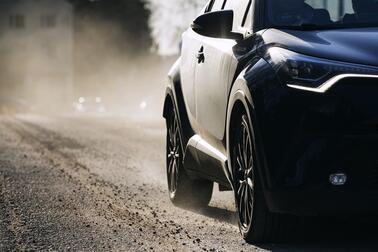
The time of switching to winter tyres will soon be at hand. We are encouraging car owners in the Helsinki Metropolitan Area to also consider the environmental impact when choosing winter tyres. According to studies, friction tyres reduce both street dust and noise. This year, Helsinki’s annual friction tyre campaign also involves Helsinki Region Environmental Services Authority (HSY), the Cities of Espoo and Vantaa, and the Ministry of the Environment.
Street dust remains a significant problem for air quality
In recent years, exhaust emissions from traffic have decreased thanks to the development of vehicle technology and air protection measures, but the street dust raised up by traffic remains a significant air quality problem. The stricter guideline values for particulate matter set by the WHO are largely exceeded. Based on the WHO guideline values, the EU will likely lower the binding threshold values for street dust in the coming years.
The main cause of street dust in cities are studded tyres: as much as half of the street dust comes from street surfaces ground by studded tyres. The days with the most dust occur in the spring, but there are such days at other times in the street dust season when the street surfaces are dry. To prevent street dust, operators in the Helsinki Metropolitan Area have developed cleaning and binding methods for street dust and anti-skid measures for the streets. Such actions have yielded good results, but the most effective way of ensuring good air quality and preventing harmful street dust is using friction tyres instead of studded ones. In addition to air quality, friction tyres also cause less noise and less wear on the streets than studded tyres.
Safe and proactive driving is more important than tyre type
The use of friction tyres has not appeared to increase accidents in Stockholm and Oslo, where a majority of winter tyres are friction tyres. While studded tyres do provide better hold on an icy road, difficult icy conditions are much rarer in the Helsinki region than the rest of Finland. In Helsinki, street surfaces are also prevented from freezing with effective anti-skid treatment based on de-icing salt.
In terms of traffic safety, the driver’s behaviour matters more than the tyre type. Anticipatory and proactive driving increases safety, and it is especially important in challenging winter conditions. Especially if the car also has anti-lock brakes and a stability control system, friction tyres are excellent for winter driving.
Environmentally friendlier tyres are promoted both nationally and locally
Raising awareness among drivers regarding the best tyre options for air quality and safety has been recorded in the National Air Pollution Control Programme approved by the Finnish Government. The City of Helsinki’s friction tyre campaign supports the City’s target of increasing the proportion of friction tyres in local winter traffic from 30% to 70% by winter 2030–2031. This target has been recorded in Helsinki’s Air Quality Plan and Noise Abatement Action Plan. To promote the target, Helsinki will start a three-year
pilot
of banning studded tyres on Lönnrotinkatu street(Link leads to external service)
in autumn 2022.
- More information about the friction tyre campaign (In Finnish)
- Impact of street dust on air quality and health(Link leads to external service)
- Helsinki Air Quality Plan 2017–2024 (PDF)
- City of Helsinki Noise Abatement Action Plan 2018–2022 (PDF)
- National Air Pollution Control Programme 2030(Link leads to external service)
Photo: Roni Rekomaa.


